The Gradient Effect on Cyclic Behavior of 316L Stainless Steel in the Ultrasonic Bending Test
Abstract
:1. Introduction
2. Experiment Procedures
3. Results
3.1. Hardness Responses with Cycles on the Surface
3.2. Hardness Response with Stress Distribution on the Surface
3.3. Hardness Responses with Stress Gradient on the Cross-Section
3.4. Deformation of Microstructures in the Cross-Section
4. Discussion
4.1. The Influence of Stress Amplitude on the Hardness
4.2. Deformation Characteristics in Gradient Stress
5. Conclusions
- (1)
- Under high-cycle bending fatigue loading, a cyclic hardening behavior was found for 316L stainless steel. As the number of cycles increases, the hardening rate increases and the change in hardening rate decreases.
- (2)
- The greater the stress amplitude, the greater the increase in hardness, whereas the greater the stress gradient, the smaller the increase in hardness.
- (3)
- As the stress amplitude increases, the mode of plastic deformation within the grain changes from single slip to cross slip.
Author Contributions
Funding
Institutional Review Board Statement
Informed Consent Statement
Data Availability Statement
Acknowledgments
Conflicts of Interest
References
- Ru, X.; Staehle, R.W. Historical Experience Providing Bases for Predicting Corrosion and Stress Corrosion in Emerging Supercritical Water Nuclear Technology—Part 2: Review. Corrosion 2013, 69, 319–334. [Google Scholar] [CrossRef]
- Lei, Y.B.; Wang, Z.B.; Zhang, B.; Luo, Z.P.; Lu, J.; Lu, K. Enhanced Mechanical Properties and Corrosion Resistance of 316L Stainless Steel by Pre-Forming a Gradient Nanostructured Surface Layer and Annealing. Acta Mater. 2021, 208, 116773. [Google Scholar] [CrossRef]
- Dryepondt, S.; Nandwana, P.; Fernandez-Zelaia, P.; List, F. Microstructure and High Temperature Tensile Properties of 316L Fabricated by Laser Powder-Bed Fusion. Addit. Manuf. 2021, 37, 101723. [Google Scholar] [CrossRef]
- Hu, Y.; Chen, Y.; He, C.; Liu, Y.; Wang, Q.; Wang, C. Bending Fatigue Behavior of 316L Stainless Steel up to Very High Cycle Fatigue Regime. Materials 2020, 13, 4820. [Google Scholar] [CrossRef] [PubMed]
- Mayama, T.; Sasaki, K.; Kuroda, M. Quantitative Evaluations for Strain Amplitude Dependent Organization of Dislocation Structures Due to Cyclic Plasticity in Austenitic Stainless Steel 316L. Acta Mater. 2008, 56, 2735–2743. [Google Scholar] [CrossRef]
- Pham, M.S.; Solenthaler, C.; Janssens, K.G.F.; Holdsworth, S.R. Dislocation Structure Evolution and Its Effects on Cyclic Deformation Response of AISI 316L Stainless Steel. Mater. Sci. Eng. A 2011, 528, 3261–3269. [Google Scholar] [CrossRef]
- Pham, M.S.; Holdsworth, S.R.; Janssens, K.G.F.; Mazza, E. Cyclic Deformation Response of AISI 316L at Room Temperature: Mechanical Behaviour, Microstructural Evolution, Physically-Based Evolutionary Constitutive Modelling. Int. J. Plast. 2013, 47, 143–164. [Google Scholar] [CrossRef]
- Marnier, G.; Keller, C.; Taleb, L. Fatigue of OFHC Pure Copper and 316L Stainless Steel Subjected to Prior Tensile and Cyclic Prestrains. Int. J. Fatigue 2016, 91, 204–219. [Google Scholar] [CrossRef]
- Zhou, J.; Sun, Z.; Kanouté, P.; Retraint, D. Experimental Analysis and Constitutive Modelling of Cyclic Behaviour of 316L Steels Including Hardening/Softening and Strain Range Memory Effect in LCF Regime. Int. J. Plast. 2018, 107, 54–78. [Google Scholar] [CrossRef]
- Xie, X.; Jiang, W.; Chen, J.; Zhang, X.; Tu, S.-T. Cyclic Hardening/Softening Behavior of 316L Stainless Steel at Elevated Temperature Including Strain-Rate and Strain-Range Dependence: Experimental and Damage-Coupled Constitutive Modeling. Int. J. Plast. 2019, 114, 196–214. [Google Scholar] [CrossRef]
- Li, H.; Jing, H.; Xu, L.; Zhao, L.; Han, Y.; Tang, Z.; Wang, X.; Zhang, Y. Cyclic Deformation Behavior of an Fe-Ni-Cr Alloy at 700 °C: Microstructural Evolution and Cyclic Hardening Model. Mater. Sci. Eng. A 2019, 744, 94–111. [Google Scholar] [CrossRef]
- Li, F.; Zhang, H.; He, W.; Zhao, X.; Chen, H. Stress Softening and Hardening during Compression and Tensile Consecutive Cyclic Loading of Mn18Cr18N Austenitic Stainless Steel. Mater. Sci. Eng. A 2017, 704, 138–146. [Google Scholar] [CrossRef]
- Li, P.; Li, S.X.; Wang, Z.G.; Zhang, Z.F. Fundamental Factors on Formation Mechanism of Dislocation Arrangements in Cyclically Deformed Fcc Single Crystals. Prog. Mater. Sci. 2011, 56, 328–377. [Google Scholar] [CrossRef]
- Grigorescu, A.C.; Hilgendorff, P.-M.; Zimmermann, M.; Fritzen, C.-P.; Christ, H.-J. Cyclic Deformation Behavior of Austenitic Cr–Ni-Steels in the VHCF Regime: Part I—Experimental Study. Int. J. Fatigue 2016, 93, 250–260. [Google Scholar] [CrossRef]
- Man, J.; Obrtlík, K.; Petrenec, M.; Beran, P.; Smaga, M.; Weidner, A.; Dluhoš, J.; Kruml, T.; Biermann, H.; Eifler, D.; et al. Stability of Austenitic 316L Steel against Martensite Formation during Cyclic Straining. Procedia Eng. 2011, 10, 1279–1284. [Google Scholar] [CrossRef]
- Cooper, A.J.; Cooper, N.I.; Bell, A.; Dhers, J.; Sherry, A.H. A Microstructural Study on the Observed Differences in Charpy Impact Behavior Between Hot Isostatically Pressed and Forged 304L and 316L Austenitic Stainless Steel. Met. Mater. Trans. A 2015, 46, 5126–5138. [Google Scholar] [CrossRef]
- Mazánová, V.; Heczko, M.; Škorík, V.; Chlupová, A.; Polák, J.; Kruml, T. Microstructure and Martensitic Transformation in 316L Austenitic Steel during Multiaxial Low Cycle Fatigue at Room Temperature. Mater. Sci. Eng. A 2019, 767, 138407. [Google Scholar] [CrossRef]
- Puchicabrera, E.; Staia, M.; Tovar, C.; Ochoaperez, E. High Cycle Fatigue Behavior of 316L Stainless Steel. Int. J. Fatigue 2008, 30, 2140–2146. [Google Scholar] [CrossRef]
- Xiong, Z.; Naoe, T.; Wan, T.; Futakawa, M.; Maekawa, K. Mechanical Property Change in the Region of Very High-Cycle Fatigue. Procedia Eng. 2015, 101, 552–560. [Google Scholar] [CrossRef]
- Fu, H.; Dönges, B.; Krupp, U.; Pietsch, U.; Fritzen, C.-P.; Yun, X.; Christ, H.-J. Microcrack Initiation Mechanism of a Duplex Stainless Steel under Very High Cycle Fatigue Loading Condition: The Significance of Load Partitioning and Micro Residual Stresses. Acta Mater. 2020, 199, 278–287. [Google Scholar] [CrossRef]
- Gao, C.; Liu, M. Instrumented Indentation of Fused Silica by Berkovich Indenter. J. Non-Cryst. Solids 2017, 475, 151–160. [Google Scholar] [CrossRef]
- Tang, S.; Wang, X.; Huang, B.; Yang, D.; Li, L.; He, C.; Xu, B.; Liu, Y.; Wang, C.; Wang, Q. A Novel Ultrasonic Fatigue Test and Application in Bending Fatigue of TC4 Titanium Alloy. Materials 2022, 16, 5. [Google Scholar] [CrossRef] [PubMed]
- Voyiadjis, G.Z.; Zhang, C. The Mechanical Behavior during Nanoindentation near the Grain Boundary in a Bicrystal FCC Metal. Mater. Sci. Eng. A 2015, 621, 218–228. [Google Scholar] [CrossRef]
- Sim, J.-H.; Kim, T.-Y.; Kim, J.-Y.; Kim, C.-W.; Chung, J.-H.; Moon, J.; Lee, C.-H.; Hong, H.-U. On the Strengthening Effects Affecting Tensile and Low Cycle Fatigue Properties of Low-Alloyed Seismic/Fire-Resistant Structural Steels. Met. Mater. Int. 2022, 28, 337–345. [Google Scholar] [CrossRef]
- Rana, A.K.; Paul, S.K.; Dey, P.P. Effect of Martensite Volume Fraction on Cyclic Plastic Deformation Behavior of Dual Phase Steel: Micromechanics Simulation Study. J. Mater. Res. Technol. 2019, 8, 3705–3712. [Google Scholar] [CrossRef]
- Bandyopadhyay, R.; Mello, A.W.; Kapoor, K.; Reinhold, M.P.; Broderick, T.F.; Sangid, M.D. On the Crack Initiation and Heterogeneous Deformation of Ti-6Al-4V during High Cycle Fatigue at High R Ratios. J. Mech. Phys. Solids 2019, 129, 61–82. [Google Scholar] [CrossRef]
- Murai, R.; Mizobe, K.; Kida, K. Evaluation of Hardness Distributions around Fracture Surface in Induction-Heated SUJ2 Steel after Rotating Bending Fatigue Test. Solid State Phenom. 2022, 331, 61–65. [Google Scholar] [CrossRef]
- Hiraoka, Y. Effect of Phase in Surface Layers on Rotating-Bending Fatigue Strength of SCM415 Steel after Austenitic Nitriding. J. Mater. Res. Technol. 2020, 9, 4894–4903. [Google Scholar] [CrossRef]
- Xue, H.Q.; Tao, H.; Montembault, F.; Wang, Q.Y.; Bathias, C. Development of a Three-Point Bending Fatigue Testing Methodology at 20kHz Frequency. Int. J. Fatigue 2007, 29, 2085–2093. [Google Scholar] [CrossRef]
- Wang, B.; Cheng, L.; Li, D. Study on Very High Cycle Fatigue Properties of Forged TC4 Titanium Alloy Treated by Laser Shock Peening under Three-Point Bending. Int. J. Fatigue 2022, 156, 106668. [Google Scholar] [CrossRef]
- Zheng, S.; Zhou, F.; Cheng, J.; Li, H.-T.; Rong, R. Experimental Study on Cyclic Hardening Characteristics of Structural Stainless Steels. J. Constr. Steel Res. 2022, 191, 107196. [Google Scholar] [CrossRef]
- Fatoba, O.; Akid, R. Uniaxial Cyclic Elasto-Plastic Deformation and Fatigue Failure of API-5L X65 Steel under Various Loading Conditions. Theor. Appl. Fract. Mech. 2018, 94, 147–159. [Google Scholar] [CrossRef]
- Polák, J.; Man, J.; Vystavěl, T.; Petrenec, M. The Shape of Extrusions and Intrusions and Initiation of Stage I Fatigue Cracks. Mater. Sci. Eng. A 2009, 517, 204–211. [Google Scholar] [CrossRef]
- Man, J.; Vystavěl, T.; Weidner, A.; Kuběna, I.; Petrenec, M.; Kruml, T.; Polák, J. Study of Cyclic Strain Localization and Fatigue Crack Initiation Using FIB Technique. Int. J. Fatigue 2012, 39, 44–53. [Google Scholar] [CrossRef]
- Mineur, M.; Villechaise, P.; Mendez, J. Influence of the Crystalline Texture on the Fatigue Behavior of a 316L Austenitic Stainless Steel. Mater. Sci. Eng. A 2000, 286, 257–268. [Google Scholar] [CrossRef]
- Man, J.; Klapetek, P.; Man, O.; Weidner†, A.; Obrtlík, K.; Polák, J. Extrusions and Intrusions in Fatigued Metals. Part 2. AFM and EBSD Study of the Early Growth of Extrusions and Intrusions in 316L Steel Fatigued at Room Temperature. Philos. Mag. 2009, 89, 1337–1372. [Google Scholar] [CrossRef]
- Man, J.; Obrtlik, K.; Polak, J. Extrusions and Intrusions in Fatigued Metals. Part 1. State of the Art and History. Philos. Mag. 2009, 89, 1295–1336. [Google Scholar] [CrossRef]
- Ye, D.; Matsuoka, S.; Nagashima, N.; Suzuki, N. Multi-Scale Deformation Behavior Investigation of 18Cr–8Ni Austenitic Steel Subjected to Low-Cycle Fatigue Loading. Mater. Charact. 2005, 55, 106–117. [Google Scholar] [CrossRef]
- Petrenec, M.; Polak, J.; Obrtlik, K.; Man, J. Dislocation Structures in Cyclically Strained X10CrAl24 Ferritic Steel. Acta Mater. 2006, 54, 3429–3443. [Google Scholar] [CrossRef]
- Wang, Q. Effect of Inclusion on Subsurface Crack Initiation and Gigacycle Fatigue Strength. Int. J. Fatigue 2002, 24, 1269–1274. [Google Scholar] [CrossRef]
- Yang, K.; He, C.; Huang, Q.; Huang, Z.Y.; Wang, C.; Wang, Q.; Liu, Y.J.; Zhong, B. Very High Cycle Fatigue Behaviors of a Turbine Engine Blade Alloy at Various Stress Ratios. Int. J. Fatigue 2017, 99, 35–43. [Google Scholar] [CrossRef]
- Wang, C.; Liu, Y.; Nikitin, A.; Wang, Q.; Zhou, M. A General Scenario of Fish-eye Crack Initiation on the Life of High-strength Steels in the Very High-cycle Fatigue Regime. Fatigue Fract. Eng. Mat. Struct. 2019, 42, 2183–2194. [Google Scholar] [CrossRef]
- Li, L.L.; Zhang, Z.J.; Zhang, P.; Wang, Z.G.; Zhang, Z.F. Controllable Fatigue Cracking Mechanisms of Copper Bicrystals with a Coherent Twin Boundary. Nat. Commun. 2014, 5, 3536. [Google Scholar] [CrossRef]
- Wilkinson, A.J.; Roberts, S.G. A Dislocation Model for the Two Critical Stress Intensities Required for Threshold Fatigue Crack Propagation. Scr. Mater. 1996, 35, 1365–1371. [Google Scholar] [CrossRef]
- Krupp, U.; Alvarez-Armas, I. Short Fatigue Crack Propagation during Low-Cycle, High Cycle and Very-High-Cycle Fatigue of Duplex Steel—An Unified Approach. Int. J. Fatigue 2014, 65, 78–85. [Google Scholar] [CrossRef]
- Dong, P.; Vecchiato, F.; Yang, Z.; Hooper, P.A.; Wenman, M.R. The Effect of Build Direction and Heat Treatment on Atmospheric Stress Corrosion Cracking of Laser Powder Bed Fusion 316L Austenitic Stainless Steel. Addit. Manuf. 2021, 40, 101902. [Google Scholar] [CrossRef]
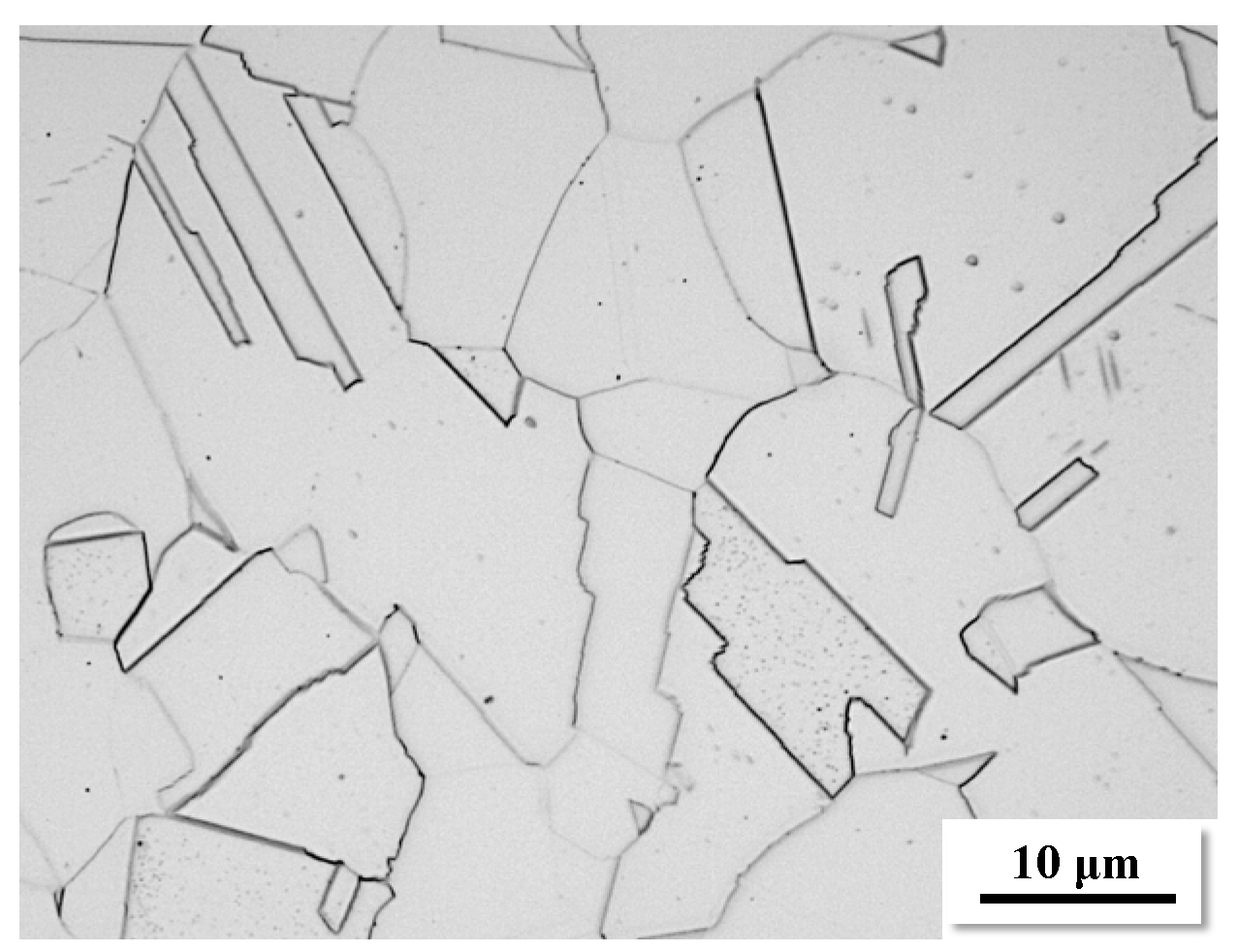
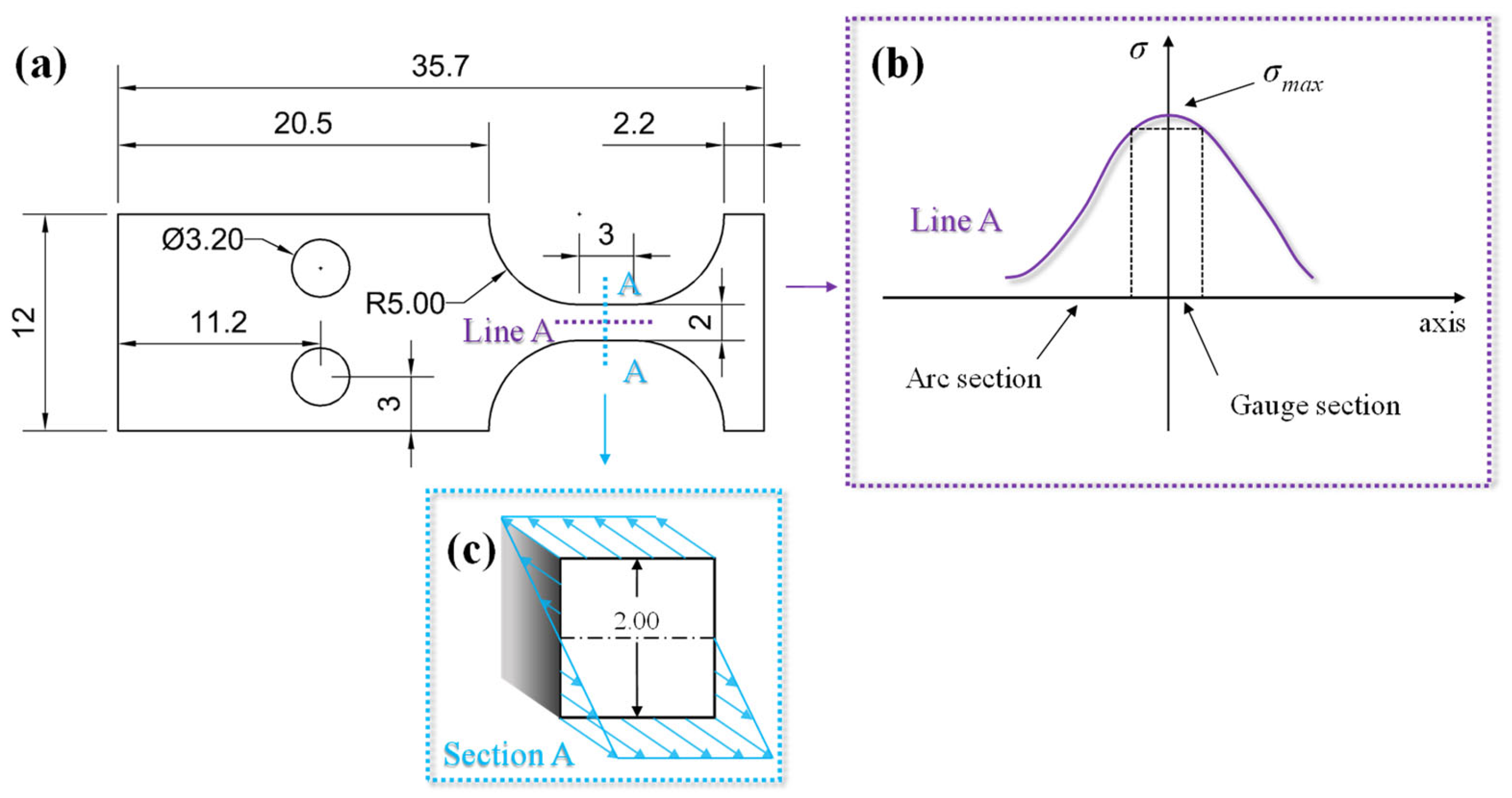
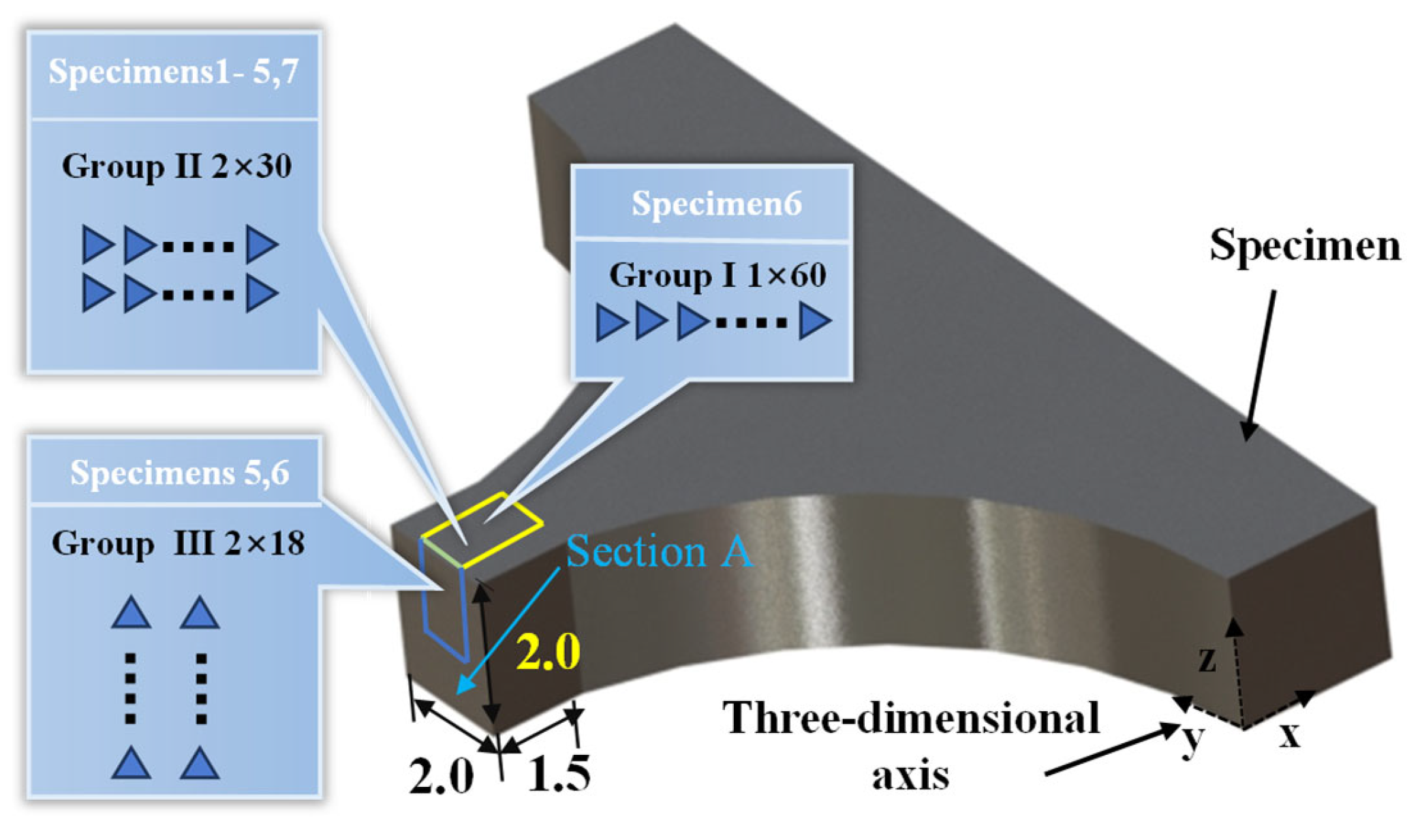
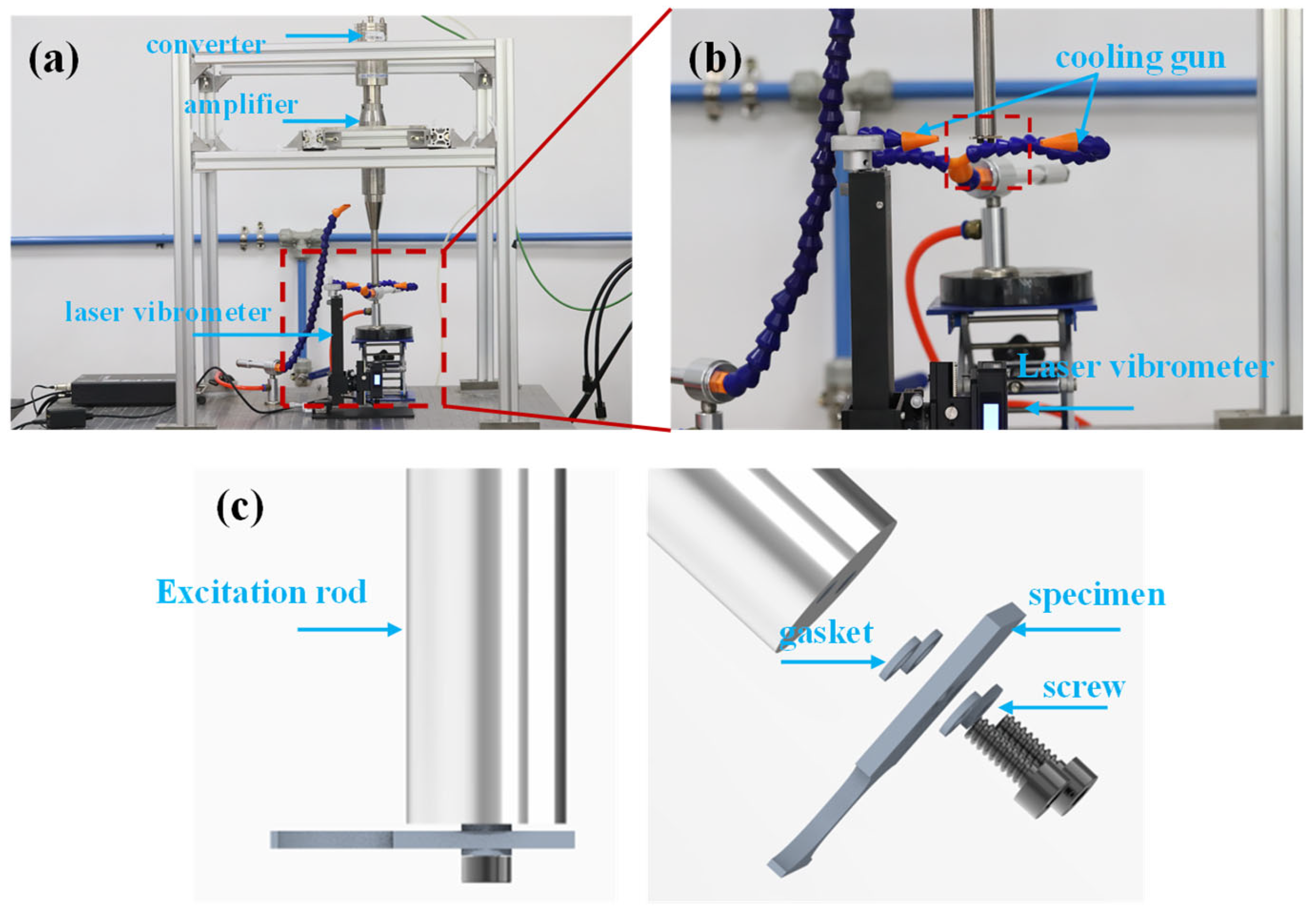
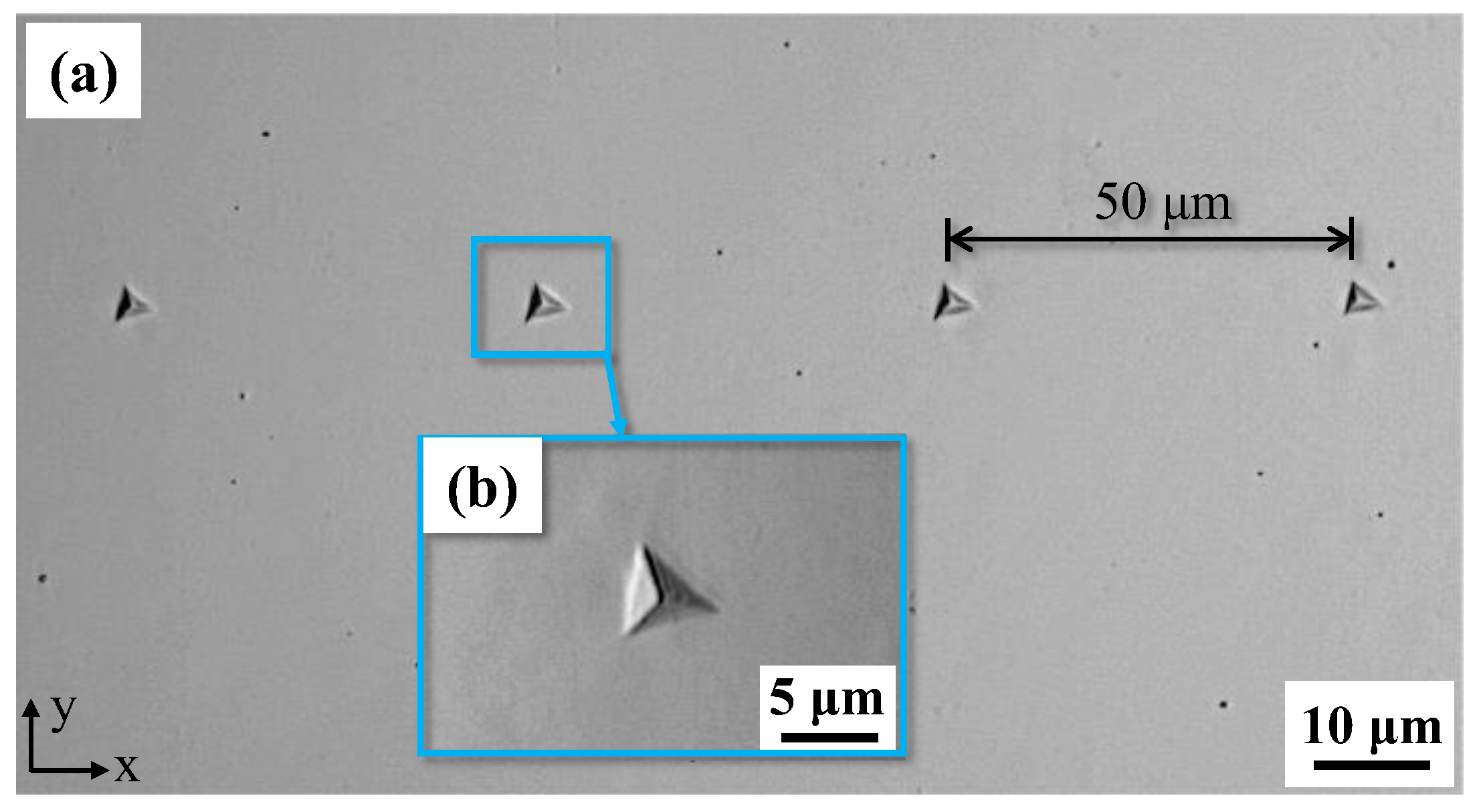
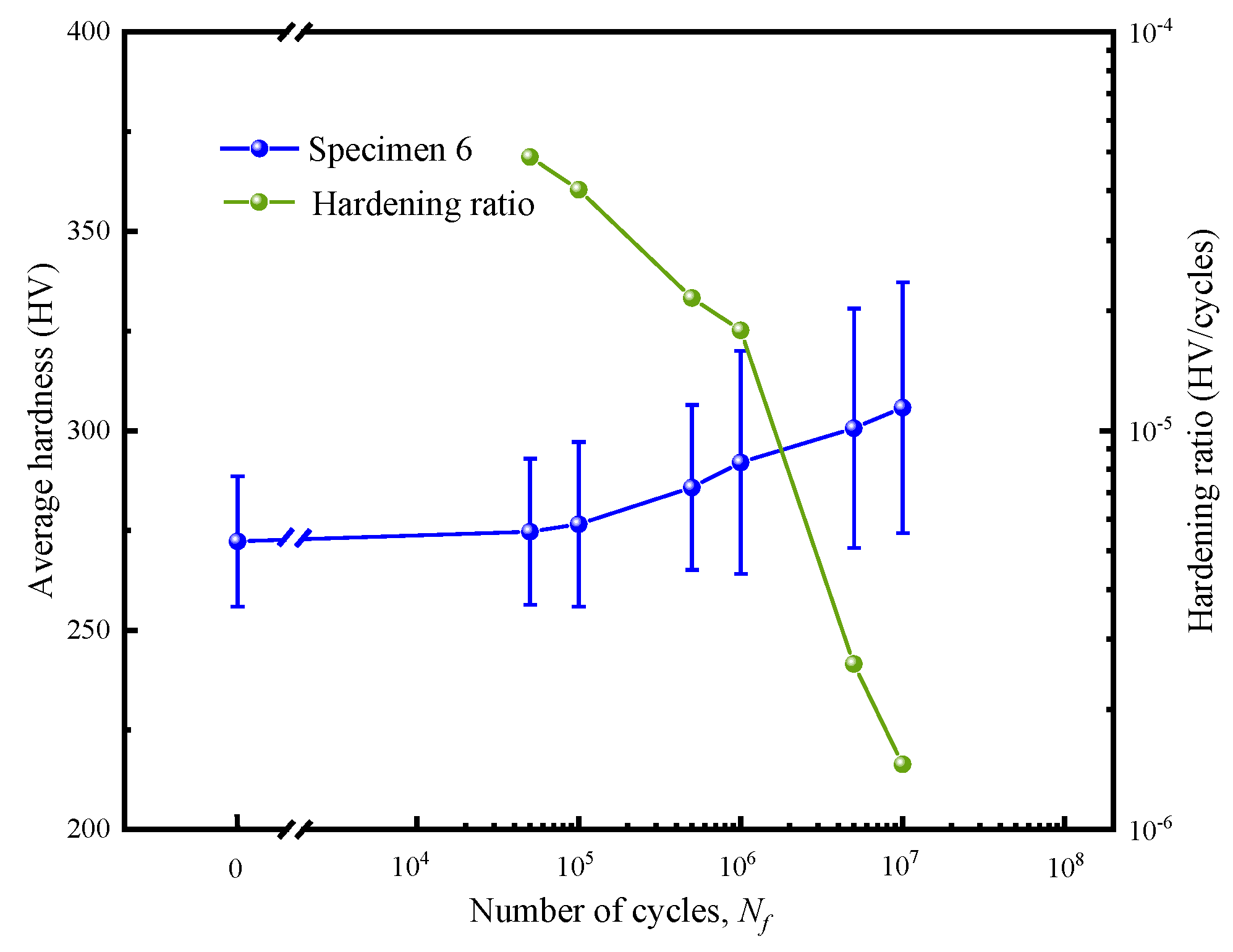

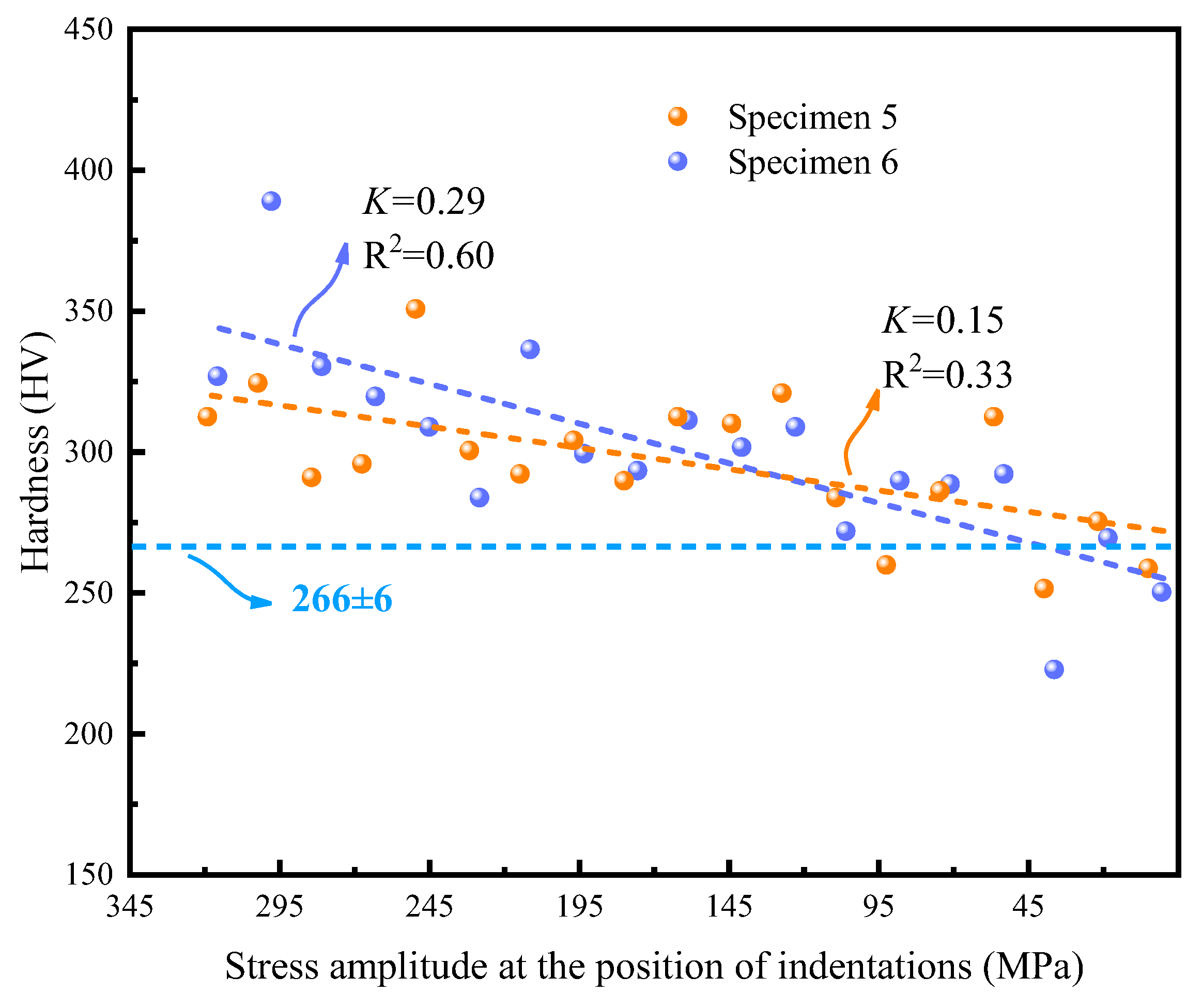
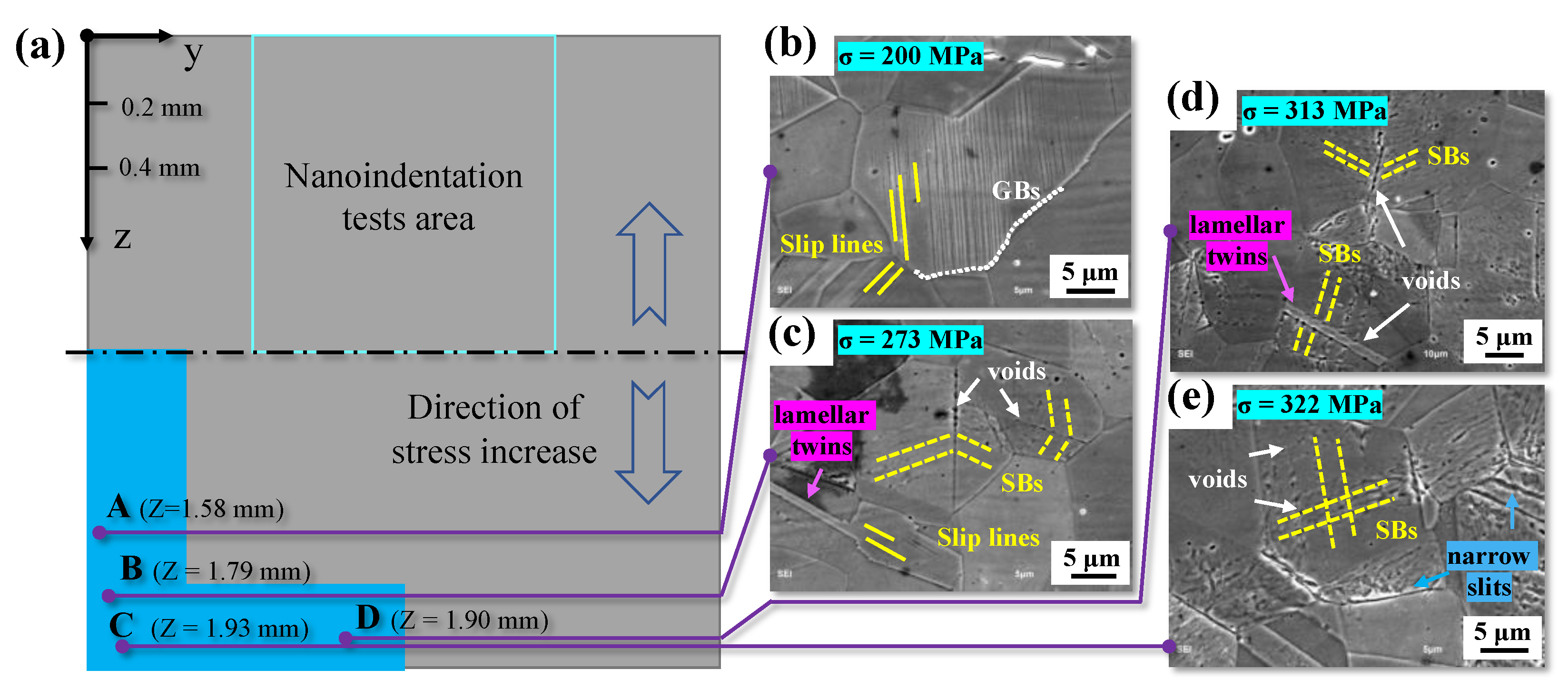
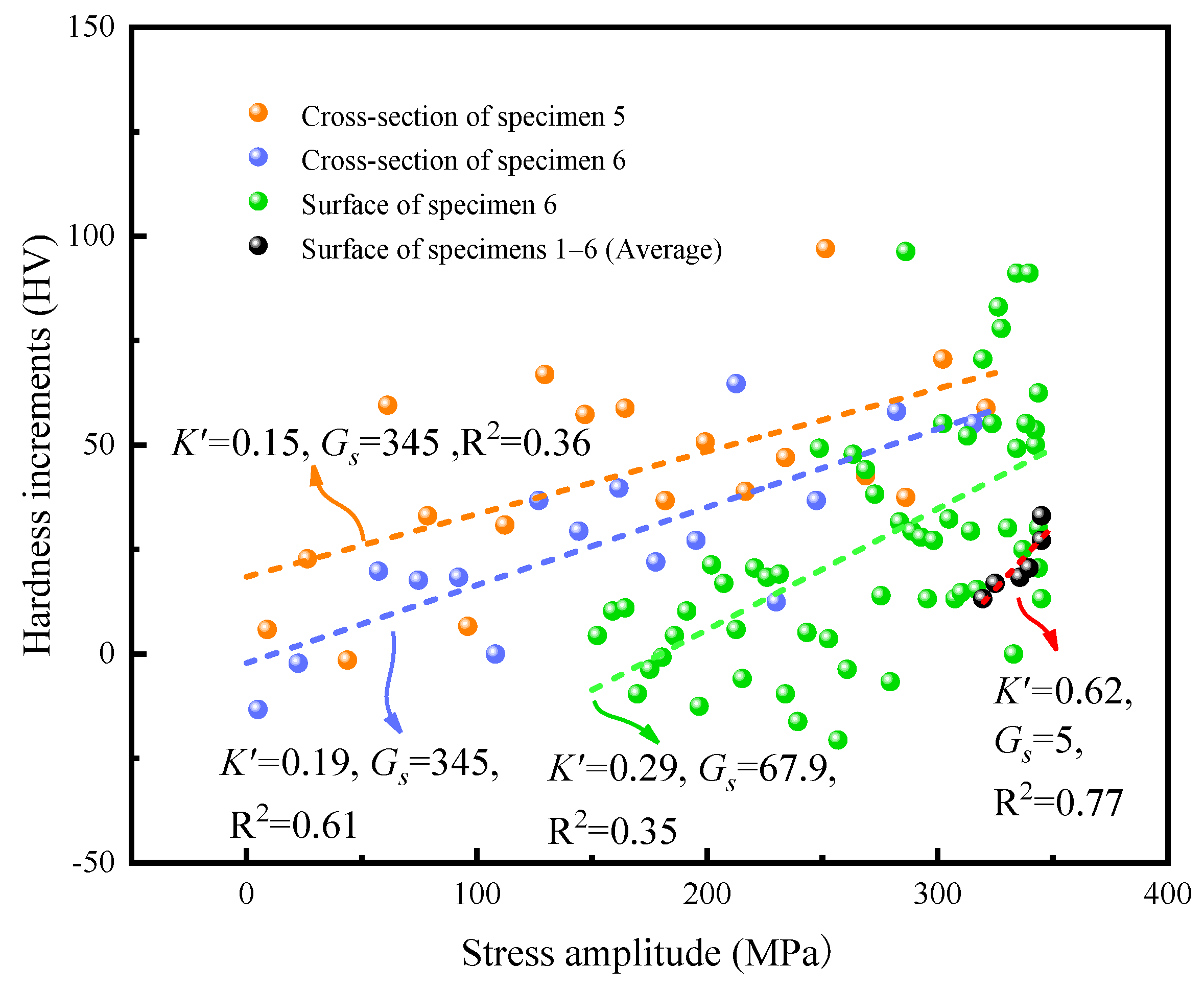
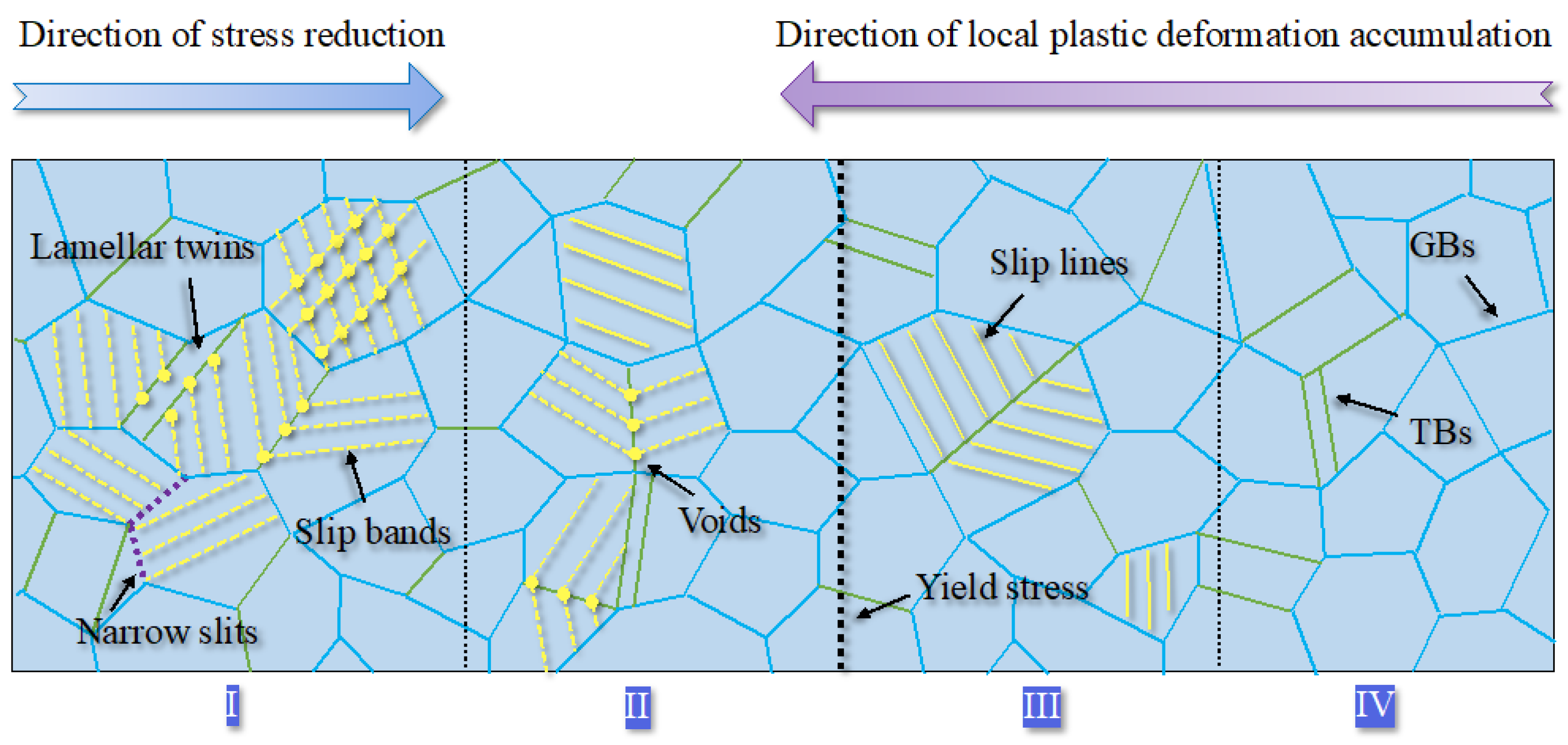
| Mechanical Properties | Value |
|---|---|
| Yield Stress (0.02%; MPa) | 220 |
| Tensile Strength (MPa) | 580 |
| Density (kg/m3) | 7990 |
| Young’s Modulus (GPa) | 195 |
| Specimen Number | Bending Fatigue Tests | Nanoindentation Tests | Average Hardness on the Surface (HV) | |||
|---|---|---|---|---|---|---|
| Stress (σa, MPa) | N (Cycles) | Arrangement Groups | Beginning | End | Difference | |
| 1 | 320 | 1 × 107 (stop) | II | 322.4 | 335.7 | +13.3 |
| 2 | 325 | 1 × 107 (stop) | II | 305.6 | 322.6 | +17.0 |
| 3 | 335 | 1 × 107 (stop) | II | 304.6 | 323.5 | +18.9 |
| 4 | 340 | 1 × 107 (stop) | II | 283.3 | 304.3 | +21.0 |
| 5 | 345 | 1 × 107 (stop) | II, III | 253.7 | 281.0 | +27.3 |
| 6 | 345 | 1 × 107 (stop) | I, III | 272.0 | 305.1 | +33.1 |
| 7 | 350 | 6.5 × 105 (rupture) | II | 288.3 | 303.9 | +15.6 |
Disclaimer/Publisher’s Note: The statements, opinions and data contained in all publications are solely those of the individual author(s) and contributor(s) and not of MDPI and/or the editor(s). MDPI and/or the editor(s) disclaim responsibility for any injury to people or property resulting from any ideas, methods, instructions or products referred to in the content. |
© 2024 by the authors. Licensee MDPI, Basel, Switzerland. This article is an open access article distributed under the terms and conditions of the Creative Commons Attribution (CC BY) license (https://creativecommons.org/licenses/by/4.0/).
Share and Cite
Hu, Y.; Tang, S.; Liu, Y.; Li, L.; Wang, C.; Wang, Q. The Gradient Effect on Cyclic Behavior of 316L Stainless Steel in the Ultrasonic Bending Test. Materials 2024, 17, 1657. https://doi.org/10.3390/ma17071657
Hu Y, Tang S, Liu Y, Li L, Wang C, Wang Q. The Gradient Effect on Cyclic Behavior of 316L Stainless Steel in the Ultrasonic Bending Test. Materials. 2024; 17(7):1657. https://doi.org/10.3390/ma17071657
Chicago/Turabian StyleHu, Yongtao, Sen Tang, Yongjie Liu, Lang Li, Chong Wang, and Qingyuan Wang. 2024. "The Gradient Effect on Cyclic Behavior of 316L Stainless Steel in the Ultrasonic Bending Test" Materials 17, no. 7: 1657. https://doi.org/10.3390/ma17071657





